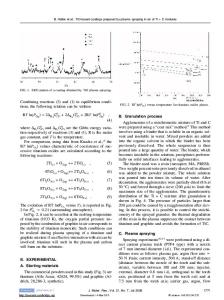Ablation Behavior of ZrB 2 -Based Coating Prepared by Supersonic Plasma Spraying for SiC-Coated C/C Composites Under Oxy
- PDF / 766,861 Bytes
- 7 Pages / 593.972 x 792 pts Page_size
- 74 Downloads / 277 Views
iyuan Yao, Hejun Li, Yulei Zhang, Kezhi Li, Qiangang Fu, and Han Peng (Submitted October 22, 2012; in revised form January 20, 2013) In order to improve the ablation resistance of C/C composites, ZrB2-based coating was prepared by supersonic atmosphere plasma spraying for SiC-coated C/C composites. The phase composition, microstructure, and anti-ablation property of the coating were investigated. Results show that the supersonic atmosphere plasma spraying is an effective method to prepare a dense ZrB2-based coating. The coating largely improves the ablation resistance of C/C composites. The linear ablation rate is 0.17 lm/s after ablation for 60 s in oxyacetylene torch. In ablation center, the ablation performance is determined by complicated mechanical denudation and chemical erosion. The formation of ZrO2 during ablation can partly prevent the diffusion of oxygen, which contributes to the good ablation resistance of ZrB2-based coating. In transition zone, the generation of SiO2 prevents inner coating from ablation and the chemical erosion becomes the leading mechanism.
Keywords
ablation, carbon/carbon composites, supersonic plasma spraying, ZrB2
coating,
1. Introduction C/C composites are used as a thermal structure component in various applications such as re-entry vehicle nose tips, leading edges, and nozzles because of their excellent mechanical properties at high temperature (Ref 1-5). In these applications, C/C composites will be subjected to thermochemical ablation by oxidation at high temperature (usually above 2073 K) and mechanical erosion by high pressure and velocity gas. However, the poor oxidation resistance of C/C composites, which react with oxygen rapidly at temperature above 773 K, restricts their high-temperature application (Ref 4, 6, 7). It is necessary to improve their ablation resistance at high temperatures and oxidizing atmosphere. The refractory ceramics, such as HfC, ZrC, TaC, HfB2, and ZrB2, are promising materials to improve the ablation resistance of C/C composites in ultrahigh temperature environments (Ref 8). Efforts have been made by coating (Ref 9-12) or by doping C/C composites with these ultrahigh-temperature ceramics (Ref 13-15). Among the Xiyuan Yao, Hejun Li, Yulei Zhang, Kezhi Li, Qiangang Fu, and Han Peng, State Key Laboratory of Solidification Processing, Northwestern Polytechnical University, XiÕan 710072, Shaanxi PeopleÕs Republic of China. Contact e-mails: yaoxiyuan-1@ 163.com and [email protected]
Journal of Thermal Spray Technology
family of UHTCs, ZrB2 is considered one of the most attractive thermal protection materials with potential application in aerospace because of its unique combination of physical and chemical properties, including moderate density (6.09 g/cm3), high melting point (3313 K), good chemical inertness, and high thermal and electrical conductivities (Ref 16, 17). The addition of SiC can improve the oxidation resistance of ZrB2 between 1273 and 2073 K because of the formation of less volatile silicacontaining scales (Ref 18). There are few re
Data Loading...











